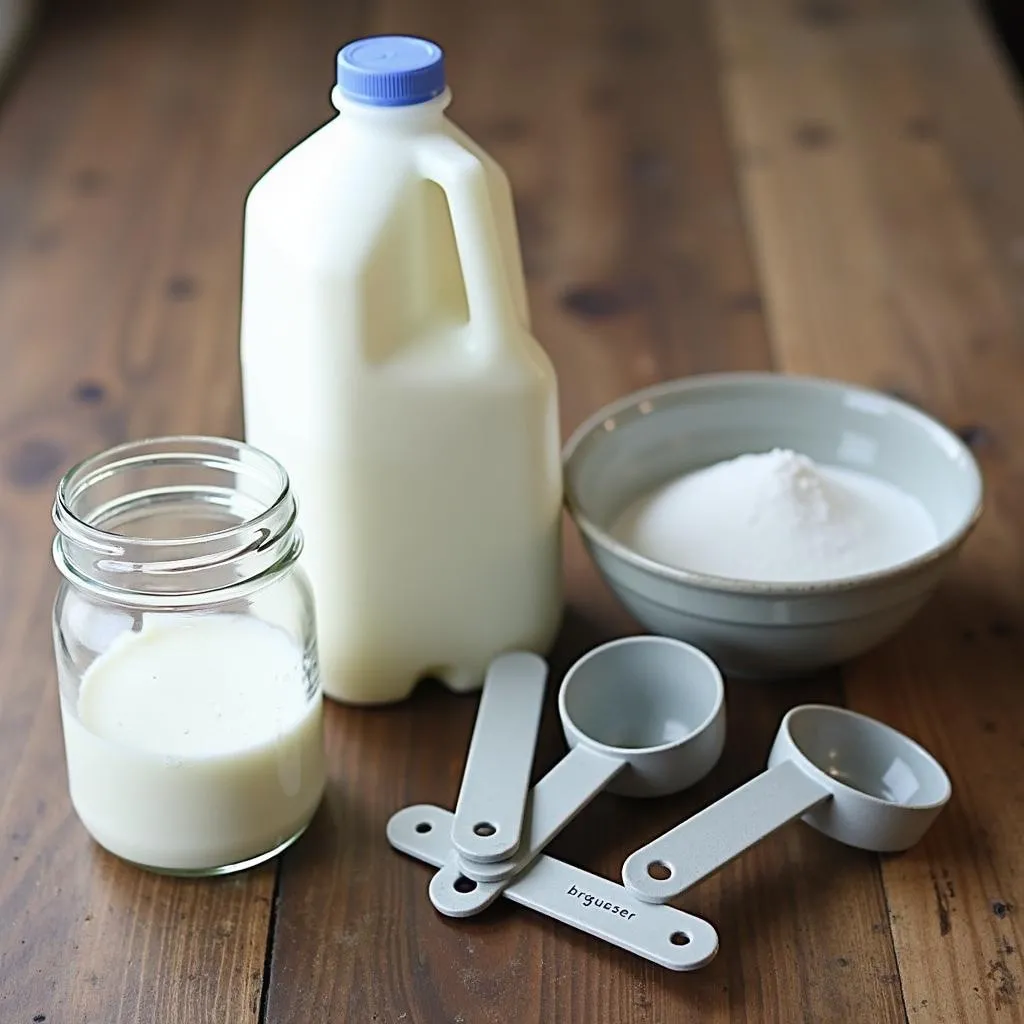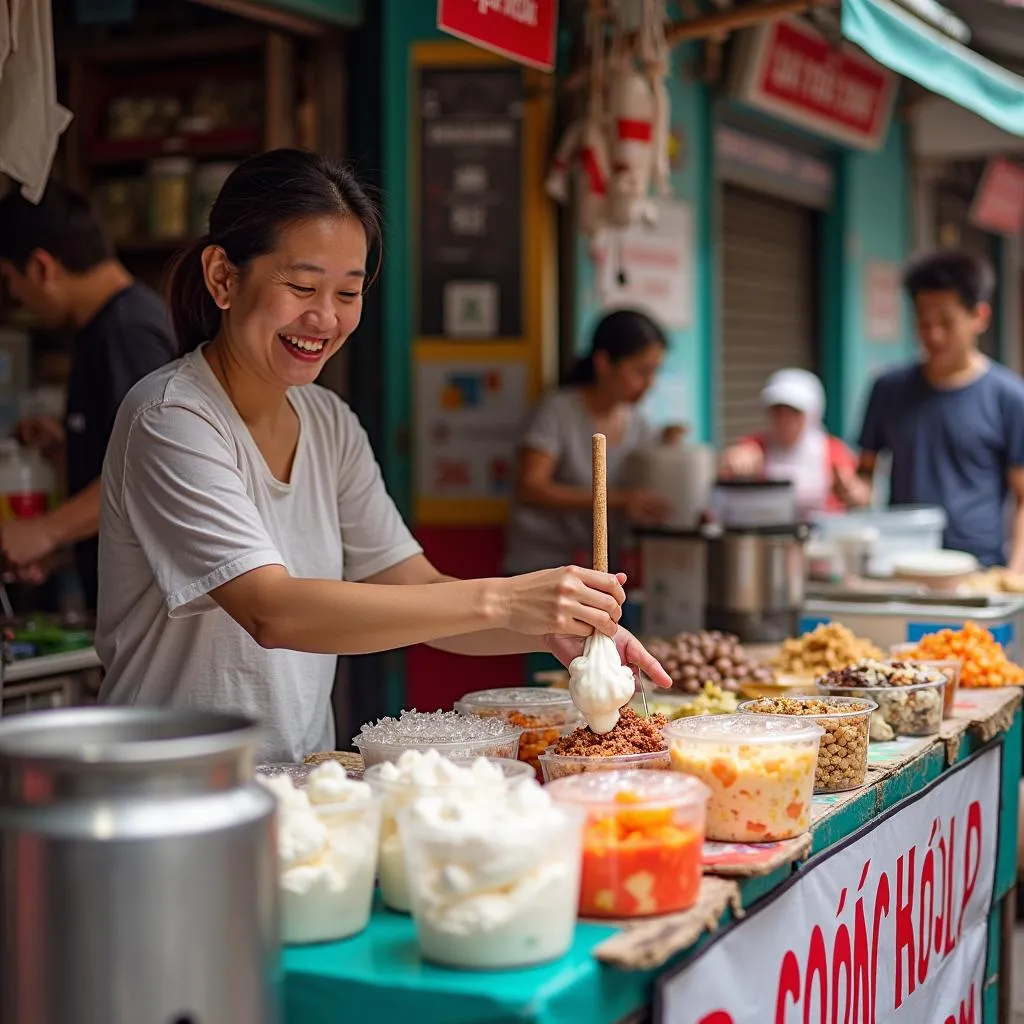Have you ever wandered through Hanoi’s Old Quarter, the scent of jasmine in the air, and found yourself captivated by the sight of colorful yogurt drinks displayed like precious jewels in local shops? These tempting treats, known as “sữa chua túi,” are a beloved Vietnamese staple, and today, I’m going to share with you the secrets of how to make this refreshing dessert at home. It’s easier than you think, and I promise the result will transport you right back to the bustling streets of Hanoi.
Cracking the Code: A Simple Recipe for Authentic Flavor
Don’t be intimidated by the exotic charm of Vietnamese yogurt; the process is surprisingly straightforward. The magic lies in the balance of just a few key ingredients:
Ingredients You’ll Need:
- Milk: 1 liter (4 cups) of whole milk, preferably not ultra-pasteurized for a richer texture. You can find high-quality milk at any supermarket in Hanoi, like the Intimex supermarket on Thái Hà Street.
- Yogurt Starter: 2 tablespoons of store-bought plain yogurt with live and active cultures. Look for brands like Vinamilk or TH True Milk, readily available in Hanoi’s convenience stores, even those nestled in quaint alleys off Hang Bac Street.
- Sugar: 1/2 cup (or to taste), but remember, Vietnamese yogurt tends to be on the sweeter side!
- Water: For creating a warm bath for the yogurt to culture.
Step-by-Step Guide:
- Preparing the Milk: Gently warm the milk in a saucepan over medium heat. You don’t want it to boil, just warm enough that it feels slightly hot to the touch. This step awakens the lactose in the milk, creating the perfect environment for the yogurt cultures to thrive.
- Tempering the Starter: In a separate bowl, whisk together a small amount of the warm milk with the yogurt starter. This step ensures the starter cultures are not shocked by the heat of the milk and can incorporate smoothly.
- Combining the Ingredients: Pour the tempered starter mixture into the saucepan with the remaining warm milk. Stir gently to combine.
- Creating the Incubation Chamber: Pour the mixture into sterilized glass jars or a large bowl. Cover tightly with a lid or plastic wrap. Now, here’s where the magic happens! Vietnamese tradition often calls for wrapping the yogurt container in a thick towel and placing it in a warm, draft-free place. Alternatively, you can create a warm water bath by filling a large pot or insulated cooler with hot water and placing the yogurt container inside.
- Patience is Key: Allow the yogurt to incubate for at least 6-8 hours, or even overnight. This time allows the live cultures to work their magic, transforming the milk into a tangy, creamy delight.
- The Final Touch: Once set, gently whisk the yogurt to achieve a smooth consistency. Add sugar to your liking and whisk again until dissolved. For an authentic Hanoi experience, transfer the yogurt into small plastic bags and chill them in the refrigerator for at least 2 hours. Snip off a corner of the bag and enjoy!
 Vietnamese yogurt ingredients
Vietnamese yogurt ingredients
A Taste of Tradition: Why Vietnamese Yogurt is Special
Vietnamese yogurt, with its unique packaging and simple ingredients, holds a special place in the hearts of locals. More than just a dessert, it’s a reminder of childhood memories, street-side conversations, and the simple pleasures in life.
- The Uniqueness of “Sữa Chua Túi”: Packaging yogurt in small plastic bags might seem unusual, but this method is deeply ingrained in Vietnamese culture. It reflects the resourcefulness and practicality of the Vietnamese people, allowing for easy portability and portion control.
- A Symphony of Flavors: Vietnamese yogurt is known for its distinct tangy flavor, a result of the fermentation process and the specific yogurt cultures used. This tanginess is balanced by a generous dose of sweetness, creating a harmonious blend that is both refreshing and satisfying.
 Hanoi street vendor selling sữa chua túi
Hanoi street vendor selling sữa chua túi
Beyond the Basics: Tips and Variations
- Thickness Control: The incubation time influences the yogurt’s thickness. For a thicker consistency, let it incubate longer. Conversely, a shorter incubation period yields a thinner yogurt.
- Flavor Adventures: While plain yogurt is the classic base, don’t hesitate to get creative with flavors! In Hanoi, you’ll find variations like condensed milk yogurt, fruit yogurt, and even yogurt topped with mung beans or black sticky rice. Let your imagination guide you!
- Temperature Matters: The ideal incubation temperature is around 100-110°F (38-43°C). A too-low temperature will slow down the fermentation process, while a too-high temperature may kill the beneficial bacteria.
- Troubleshooting: If your yogurt doesn’t set, don’t lose heart! It could be due to various factors like the freshness of your starter, incubation temperature, or even the type of milk used. Try again, paying close attention to the details, and you’ll be rewarded with delicious homemade yogurt.
Need a Helping Hand? TRAVELCAR is Here!
Craving that authentic Hanoi yogurt experience but don’t have the time to whip it up yourself? No worries! Contact TRAVELCAR. We can arrange a delightful food tour through Hanoi’s charming streets, where you can sample the best “sữa chua túi” the city has to offer.
We’re just a phone call away at 0372960696, or drop us an email at [email protected]. Our office is conveniently located at 260 Cầu Giấy, Hà Nội.
So, go ahead and embark on your Vietnamese yogurt-making adventure. And if your travels bring you to Hanoi, let TRAVELCAR be your guide. We’ll help you discover the hidden gems and culinary treasures this enchanting city has to offer.
